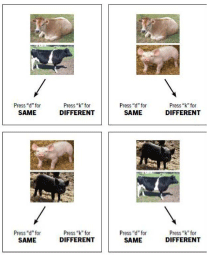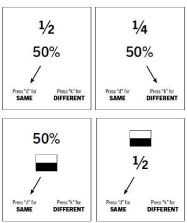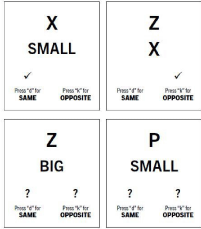
Review Article
Austin J Autism & Relat Disabil. 2017; 3(2): 1041.
Teaching Important Relational Skills for Children with Autism Spectrum Disorder and Intellectual Disability Using Freely Available (GO-IRAP) Software
Murphy C¹* and Barnes-Holmes D²
¹Department of Psychology, National University of Ireland Maynooth, Ireland
²Department of Psychology, Ghent University, Belgium
*Corresponding author:Carol Murphy, Department of Psychology, National University of Ireland Maynooth, Maynooth, Ireland
Received: June 01, 2017; Accepted: August 21, 2017; Published: August 30, 2017
Abstract
The current article is a brief summary of recent research in relational responding with an emphasis on the Ghent Odysseus Implicit Relational Assessment Procedure (GO-IRAP) for teaching this important skill to children with diagnosed autism. Relational responding, especially derived (emergent, untaught) relational responding is thought to be related to complex human cognition such as language and other symbolic understanding (e.g., algebra, maths). Research has indicated that fluent and flexible relational responding is correlated with higher scores on standardized ability/ IQ tests, and that even quite complex relational skills may be taught to children with autism using Multiple Exemplar Training (MET) with other behavioural principles such as positive reinforcement. The GO-IRAP is an interactive computerised teaching programme conceptualized by Professor Dermot Barnes-Holmes and colleagues, which has been made freely available to practitioners and parents. This is a teaching tool designed to assess and teach relational responding from basic nonarbitrary/ physically-based relations such as coordination (same-different), comparison (greater-lesser), opposition, temporal (before-after, hierarchy, deictic relations (I-YOU), and arbitrary relations (.50=50%; X=Y) including Derived Relational Responding (DRR; teach A is greater-than B and B is greater-than, test if child derives (untaught) B is smaller than A, C is smaller than A, A is bigger than C). The current article provides some examples of the diverse relations that can be taught, and stimuli and feedback that can be presented; notably, ongoing research with the GO-IRAP may bring further refinements.
Introduction
EIBI and Importance of Language/ Communication
Behavioural research by Hayes et al. [1], and Sidman [2] has lead to new progressive behavioural teaching applications that aim to integrate relational responding, generativity and other complex aspects of language in Early Behavioural Intensive Intervention (EIBI) for children with autism or intellectual disabilities [3-5,6] Rehfeldt & Root, 2005; [7] Rosales & Rehfeldt, 2007; [8] Kilroe, Murphy, Barnes-Holmes & Barnes-Holmes, 2013 [9] Rehfeldt & Barnes-Holmes, 2009. Practical applications using EIBI to improve educational and intellectual functioning in children with autism commenced mainly with Lovass [10] using positive reinforcement (similar to contingent reward), punishment, prompting, fading, and many other behavioural principles. Beneficial outcomes from these “Applied Behaviour Analysis” (ABA) teaching procedures were that participant children (N=19) showed higher educational achievements and higher IQ scores compared to matched peers who did not undergo ABA/EIBI; further research after an extended time period showed that benefits for participants were maintained over the longterm [11]. More recently, many impartial reports have supported ABA/EIBI as an effective treatment with a supporting evidencebase for remediating skill deficits in children with autism [12]. Skinnerian behavioural principles [13] and his functional account of language [Verbal Behavior] [14] are foundational to successful ABA treatment programmes, in which language and communication have been traditionally targeted as a priority [15]. Noted limitations, however, were that ABA largely failed to target emergent, novel speech utterances, or the generativity that is characteristic of human language [1]. This was thought to be due to the absence of a complete and comprehensive behavioural account of these more complex aspects of human language and cognition.
Relational frame theory/ Derived relational responding: A modern behavioural language theory termed Relational Frame Theory [RFT; 1] has expanded the behavioural research agenda into the more complex areas of human language. The theory encompasses phenomena such as generativity, irony, sarcasm, and humour (readers unfamiliar with RFT may find it useful to commence with Torneke’s [16] account, which is readily understood). Of fundamental importance is Derived Relational Responding (DRR), which was documented in early behavioural research investigating the stimulus equivalence phenomenon. The kernel of Stimulus Equivalence (SE) and DRR is that human language entails derived, emergent or untaught responding. For example, if language-able humans are taught that A is same-as (equivalent to) B, they can derive B as equivalent to A without being taught this bi-directional relations. If they then learn B same-as C relations, they can derive A same-as C and C same-as A relations without direct teaching. Sidman’s research [2] showed that when a boy with intellectual disability was taught to relate a written word in relation to a picture, and was taught to relate that picture to a spoken word, he derived relations between the written word and the spoken word, without the necessity of teaching. This type of responding was thought to hold much promise for establishing language repertoires involving derivation in children with ID or autism and related language deficits. In practical terms however, teaching applications involving stimulus equivalence research were slow to follow, and work in the area of SE and DRR remained mainly in the basic research literature for years if not decades.
In relatively recent behavioural history, RFT researchers have fleshed out a comprehensive account of DRR, and are continuing to build a solid body of supporting research, including translational research conducted with children with autism and or ID (e.g., demonstrated derived requesting with children with autism [3-5]; showed derived requesting in adults with severe ID [6]; and other DRR skills with individuals with ID [17,18]. Many different types of DRR were expanded upon by RFT, not only derived equivalence relations, RFT described relational “frames” of distinction, opposition, comparison, hierarchy, temporal relations, deictic relations involved in perspective-taking (e.g., I-You/Here-There/Now-Then) and many others [1]. The theory also clearly differentiated between relational responding that is arbitrary and nonarbitrary, emphasizing the importance of the former over the latter.
Arbitrary relational responding: Arbitrary relational responding in RFT refers to relations that are socially designated with no physical basis, as when the word “tree” is assigned a coordinate relation (same-as) with the object tree, or when, for example, mathematical symbols are used to represent equations. Nonarbitrary relations are based on physical characteristics, for example, two identical black cats may form an equivalence relation; cats and dogs may participate in a coordinate relation in that they belong to the category “animals” based on nonarbitrary similarities such as having four legs and fur. The said dogs and cats may also participate in a nonarbitrary relational frame of comparison; the dog in some instances being physically greater than the cat, and sometimes vice versa. In contrast, an arbitrary comparative relation may be described when a language-able human is taught that regardless of physical size, an arbitrary stimulus, coin “A”, is established as “greater than” coin “B”, and B is established as greater than C, he or she can derive without further teaching that B is less than A, C is less than A, and A is greater than C. This type of DRR is said to involve a transformation of functions via stimulus relations; the value function of coin C is transformed due to its relation with coin B and so on.
Because this type of complex responding would seem essential in language and higher cognitive functioning [1], applied behavioural researchers have begun to integrate relational responding in ABA teaching programmes in combination with more well-known behavioural such as positive teaching technologies involving positive reinforcement. For example, a comprehensive RFT-based protocol named PEAK (Promoting Emergent Advanced Knowledge; [19,20] has been designed to assess relational responding skills present in the repertoires of children with autism and or ID, with detailed instructions for subsequently teaching relational responding found absent, from basic to advanced levels. Indeed, in a relatively short space of time, the PEAK programme has garnered considerable empirical support regarding correlations with established standardized measures of cognitive ability and intelligence [21,22]. Another emergent RFT-based relational training programme is the TARPA (Training & Assessment of Relational Precursors & Abilities), which is a computer-based protocol for the assessment of relational responding [23,24].
Relational flexibility and intelligence: Correlations between relational training performance and measures of ability or intelligence accord with previous predictions of RFT theory and research; a study with typically-developing adult participants showed that rapid relational responding was correlated with higher IQ scores [25,26]. These studies showed also that flexibility in relational responding was even more important; to illustrate, the ability to relationally respond with speed with reversed contingencies was more strongly associated with higher IQ scores than speed of responding per se. An example of contingency reversals is as follows: to begin, an A> B relation is reinforced as correct; a reversed contingency means a B>A relation is reinforced as correct; a double-reversal means that A>B is again reinforced as correct. Performance of participants who responded rapidly to such contingency reversals in relational responding was found to be more strongly associated with higher IQ scores, compared to participant performance data showing rapid relational responding per se [25]. The proposition that complex relational responding is correlated with higher IQ scores has received preliminary research support also in the domain of behavioural application. An applied research study recorded IQ measures pre and post relational training with children who were educationally disadvantaged, and found that participants who had learned complex (arbitrary) relational responding showed gains on IQ measures post-training [27] (i.e., minimum one standard deviation on the full-scale Wechsler Intelligence Scale for Children, WISC-IVUK [28] compared to those who learned less complex relational training (e.g., more basic nonarbitrary relations that are based on physicality), whose IQ measures mostly remained stable.
Intuitively, it seems likely that teaching speed and flexibility in relational responding may be more readily facilitated via an interactive computerised teaching programme compared to one-onone table-top teaching, and there has been some research to support this assumption, conducted with children with autism [8,29]. The lure of computer software teaching programmes is that by their nature they allow for rapid and consistent teaching-trial presentation, because a teacher or instructor does not have to physically manipulate and arrange presentation and removal of an array of stimuli. In addition, they can provide consistent delivery of feedback for correct and incorrect student responding across training trials. It is also possible that the student can practice learning independently, which is advantageous in terms of student automaticity and teacher resources. (Notwithstanding these advantages, a computerised teaching programme could not and should not be considered as a replacement for instructor-led teaching, but could be seen as potentially complementary to one-on-one and other instructor-lead classroom learning, which of course should always be valued as the mainstay of educational teaching and learning).
IRAP: Implicit relational assessment procedure
The Implicit Relational Assessment Procedure (IRAP) is a computer software programme that was designed by Professor Dermot Barnes-Holmes [30], who was co-author of RFT theory [1], and who, with his wife and colleague Dr. Yvonne Barnes-Holmes, has been to the forefront in conducting basic and translational research in RFT and DRR. Their work has also led to a practical handbook with detailed descriptions on how to design behavioural applications based on RFT and DRR, in combination with traditional behavioural teaching and intervention technology [9].
As a research tool, the IRAP has been gaining ground as a behaviourally based measure of relational responding that contributes to the research literature on implicit stereotyped responding or prejudice, in socially sensitive areas in which participants may not wish to report negative bias and indeed may be unaware that they are prone to bias. The IRAP has been used to demonstrate participant’s implicit stereotype in areas such as race, attractiveness (i.e., beautybias [31], bodyweight (thin-positive versus fat-negative [32,33], social stigma toward autism [34], race stereotype [35], sexual orientation stereotype [36], and age stereotype [37], to mention just a sample. In such procedures the IRAP tasks involve participants affirming verbal relations presented onscreen, in trial-blocks that are alternatively consistent and inconsistent with stereotype responding. The assumption is that participants will respond faster when the relations presented are in accord with relations they previously learned within the social community (e.g., thin-positive; fat-negative are relations considered to be consistent with pre-learned social stereotype within the verbal community; inconsistent trial-blocks would present these relations reversed). The IRAP response latency data for consistent and inconsistent trial-blocks are analyzed in aggregate to determine if response latency data for consistent trial-blocks were significantly shorter compared to response latency data for inconsistent trialblocks, shorter latencies for consistent trial-blocks are deemed to indicate stereotyped responding in a relevant IRAP investigation [38].
T-IRAP: Interactive computerised teaching programme
Returning to teaching relational responding using the IRAP, this computer software was readily adapted for teaching relational responding with children with diagnosed ASD, and a range of picture stimuli gleaned from websites such as Board maker and similar were inserted (T-IRAP; ‘T’ for Teacher) [8,29,40]. Kilroe et al. [8] showed that 8 participants with diagnosed ASD (boys and girls aged 8-10 years, described as ‘high-functioning’) successfully learned to use the T-IRAP, and learning outcomes for relational responding showed greater speed and accuracy with T-IRAP compared to Table-Top teaching conditions with one-on-one instruction. The relational skills targeted with both T-IRAP and TT commenced initially with nonarbitrary coordination relations (e.g., animal categories, see Figure 1), then taught opposition relations (Figure 2), followed by arbitrary coordination relations (e.g., .50 same-as &su; ½ different-from ¼, Figure 3) arbitrary comparative relations (Figure 4), and derived arbitrary comparative relations (Figure 5). This DRR procedure involved the following sequence: teach/ reinforce the relations, “X” same-as SMALL, Z opposite-to X, Z same-as P; then test for Derived Arbitrary Comparative Relations (DRR), i.e., does participant correctly select response option SAME when sample stimulus (above) is Z and comparison stimulus is BIG (below) and select OPPOSITE when Z is presented with SMALL; does participant similarly select SAME when P is presented with BIG and select OPPOSITE when P is presented with SMALL).

Figure 1: Nonarbitrary coordination relations (e.g., select SAME when trial
presents 2 pigs; select DIFFERENT when trial presents a pig and a cow).

Figure 2: Nonarbitrary opposition relations (e.g., select SAME when trial
presents 2 night-scenes; select OPPOSITE when trial presents a night-scene
and a day-scene and cow is presented).

Figure 3: Arbitrary coordination relations (e.g., select SAME when trial
presents 50% with the symbol indicating half, and select DIFFERENT when
trial presents 50% with 1/4).

Figure 4: Arbitrary comparative relations: Smaller coin has greater currency
value than larger. Participants learns to reference responding to sample (top)
stimulus such that if the €1 coin is the sample stimulus, the correct response
option is MORE, if the 50c coin is presented as sample the correct response
option is LESS.

Figure 5: Derived arbitrary comparative relations (DRR) based on SAMEOPPOSITE
relations: Participants were taught relations: X same-as SMALL,
Z same-as P, Z opposite to X. Test trial for DRR depicted in graphic: Z same
or opposite to BIG? P same or opposite to SMALL? DRR response based on
taught relations is Z and P are both same-as BIG.
As stated previously, derivation is a skill that seems likely to contribute to exponential learning and the DRR training and testing with arbitrary stimuli would seem advantageous. For students who fail to derive the relevant relations, this can be taught using Multiple Exemplar Training (MET); in the current example, students would then undergo training with T-IRAP that taught/reinforced the relations that should be derived (e.g., select SAME when either Z or P are presented with BIG, and select OPPOSITE when either are presented with small). When the student successfully learns to relate these stimuli, the endeavour is repeated with an entirely new set of stimuli, ending with another test for DRR. If the student again fails, the MET procedure is conducted with the new stimuli, and these procedures can be repeated until the student demonstrated the targeted DRR skills.
Research by Murphy et al. [29] used the T-IRAP with children with autism described as ‘low-functioning’, to compare learning outcomes in terms of speed and accuracy of relational responding during T-IRAP and TT teaching conditions. This research showed that participants diagnosed with ‘low-functioning’ autism successfully learned to use the T-IRAP computer programme; if a participant initially had difficulty learning correspondence between response options presented onscreen and corresponding keys on the keyboard, a practical intervention proved effective. Comparison of participants’ learning outcomes showed that speed and accuracy in relational responding were improved under T-IRAP conditions compared to TT teaching conditions. Dennehy et al. [39] showed that a 5 yearold girl with diagnosed autism successfully demonstrated analogy relations using the T-IRAP programme and a methodology drawn from RFT that elucidates analogy as the skill of relating relations (e.g., dog: cat: daisy: rose is an analogy that involves “equivalence: equivalence” relations in which the first animal equivalence relation (dog: cat) is seen as similar to the second flower equivalence relation (daisy: rose).
GO-IRAP: Advanced teaching tool
The T-IRAP research protocol was precursory to a much more sophisticated and highly developed interactive computerised relational assessment and teaching procedure, namely the GO-IRAP (GO is representative of the Ghent Odysseus research programme which funded this research endeavour, in which Prof. Barnes- Holmes’ original conceptualization of the IRAP and later the T-IRAP was enhanced with the assistance of Dr. Ian Hussey and Dr. Ciara McEntaggart. Before expanding on the GO-IRAP interactive computerised teaching programme, it is perhaps important to note that although software programmes of this type usually involves a financial cost to the user, the GO-IRAP has been made freely available for practitioners and parents alike at the following website: https:// contextualscience.org/ (or else contact Professor Dermot Barnes- Holmes, at the Department of Experimental Clinical and Health Psychology, Ghent University, BE-9000, Belgium; email: Dermot. Barnes-Holmes@ugent.be). The GO-IRAP has the capacity to present not only a wide range of relational responding teaching procedures (see Table 1), but can also be quite readily adapted for use with children at different levels of learning, and it comes with a manual.
GO-IRAP can assess and train various types of relational responding
1
Same Different (equivalence, distinction relations)
2
Same Opposite (equivalence, opposition relations)
3
Similar Different (coordination, distinction relations
4
Analogy (relating relations)
5
Before After (temporal relations)
6
More than Less than (comparative relations)
7
More Likeable Less Likeable (comparative relations with emotional valence)
9
Prepositions (spatial relations)
10
Tacting (labelling)
11
Probing/assessment
12
Fluency in relational responding (responding quickly and correctly)
13
Flexibility in relational responding (responding quickly and correctly when previously learned verbal relations are reversed)
14
Derived relational responding via multiple exemplar training
Table 1: Some examples of what you can do with the GO-IRAP.
The potential array of relational stimuli that can be presented onscreen in the GO-IRAP is almost infinite, and picture stimuli or word stimuli can be used; simple one-word stimuli can be used (e.g., word “CAT” presented with “CAT”, select response option for SAME) or more complex relational responding with word sentences (e.g., “tree is to leaf as flower is to petal”; “dog: puppy; cat: ______”). The presentation of stimuli can be randomised using a setting on the GO-IRAP, and the presentation of response options can be fixed or randomised also, however, early learners will usually benefit by commencing with fixed location response options, and then exposed to random right/left location of response options to develop more fluent and flexible relational responding. The GO-IRAP can be used as an assessment of relational responding, or as a training procedure for relational responding. Correct responding on the GO-IRAP can be signaled to the early learner via smiley face picture images, ‘thumbs up’ or other selected images (e.g., photo image of play area, or of toy or small edible; JPG, PNG and GIF formats can be used) presented onscreen immediately after correct responding. All users facing text within the GO-IRAP can be customized to the local language and according to the task you are presenting. Most character sets are supported, including Japanese, Swedish, Hebrew, Polish et cetera. Feedback for incorrect responding might be a red X, or the words “Try again” presented onscreen immediately following the incorrect trial. As student’s progress with learning, printed words such as “Good Job”, “Well done” or “You get two tokens” can be used.
For the advanced learner the continuity of training trials can signal correct relational responding without impeding the student’s speed, and suitable feedback can be customized; success criteria can be pre-set on the T-IRAP in terms of speed and accuracy of responding, for example, 80% correct responding, speed set at 5000 milliseconds for a specified trial-block. The student can be provided with feedback regarding his or her speed and accuracy in relational responding, and can begin learn to self-manage learning by graphing their own data, obtaining reinforcement for meeting the preset criteria. Correct and incorrect data can be recorded for each session for the student, as well as speed of responding (e.g., John, Days 1-3):
1. John Day 1, 56.25% and 124ms.
2. John Day 2, 81.25% and 1101ms.
3. John Day 3, 100% and 681ms.
There is a file on the T-IRAP (graphing.xls) which can show highlights of where to look and how this is easily graphed. Training and test trials can be arranged, and the number of practice trialblocks and test trial-blocks can be specified in the GO-IRAP. Practice trial-blocks can be continued until the criteria specified are met (i.e., specified the number under ‘Mastery Criteria’). This is a particularly useful option for teaching when relational responding repertoires are weak or absent. All onscreen stimuli on the GO-IRAP, including the response options, can be can be adjusted to suit the desired purpose, and the screen can present a range of choices that can be made among various settings. Furthermore, Prof. Barnes-Holmes emphasizes that the GO-IRAP remains a work in progress, and its capacity and adaptability as an interactive teaching tool is constantly being developed [40,41], thus, things can only get better in that regard.
Conclusion
The free availability of the GO-IRAP interactive computerised teaching programme may encourage more behavioural practitioners (and parents who are reasonably computer savvy) who are interested in integrating DRR into their curricula for teaching children with ASD, who are prone to somewhat ‘rigid’ language, with limited generativity. These children, like their typically developing peers, are frequently drawn to computers perhaps due to the bright colorful images, thus, they may find the GO-IRAP programme an attractive tool with which to practice relational learning, which will hopefully be of benefit in advancing language and cognitive repertoires.
References
- Hayes SC, Barnes-Holmes D, Roche B. Relational Frame Theory: A Post- Skinnerian account of human language and cognition. New York: Plenum Press. 2001.
- Sidman M. Reading and auditory-visual equivalences. Journal of Speech and Hearing Research. 1971; 14: 5-13.
- Murphy C, Barnes-Holmes D, Barnes-Holmes Y. Derived manding in children with autism: Synthesizing Skinner’s verbal behavior with relational frame theory. Journal of Applied Behavior Analysis. 2005; 38: 445-462.
- Murphy C Barnes-Holmes D. Establishing derived manding for specific amounts with three children: An attempt at synthesizing Skinner’s Verbal Behavior with relational frame theory. The Psychological Record. 2009; 59: 75-92.
- Murphy C, Barnes-Holmes D. Establishing complex derived manding with children with and without a diagnosis of autism. The Psychological Record. 2010; 60: 489-504.
- Rehfeldt R, Root S. Establishing derived requesting skills in adults with severe developmental disabilities. Journal of Applied Behavior Analysis. 2005; 38: 101-105.
- Rosales R, Rehfeldt R. Contriving transitive conditioned establishing operations to establish derived manding skills in adults with severe developmental disabilities. Journal of Applied Behavior Analysis. 2007; 40: 105-121.
- Kilroe H, Murphy C, Barnes-Holmes D, Barnes-Holmes Y. Using the T-IRAP interactive computer program and applied behavior analysis to teach relational responding in children with autism. Behavior Development Bulletin. 2014; 19: 60-80.
- Rehfeldt R, Barnes-Holmes Y, Steven C. Hayes. Derived Relational Responding Applications for Learners with Autism and Other Developmental Disabilities: A Progressive Guide to Change. Oakland: New Harbinger Publications. 2009.
- Lovaas OI. Behavioral treatment and normal educational and intellectual functioning in autistic children. J Consult Clin Psychol. 1987; 55: 3-9.
- McEachin JJ, Smith T, Lovaas OI. Long-term outcome for children with autism who received early intensive behavioral treatment. Am J Ment Retard. 1993; 97: 359-372.
- Larsson EV. Is Applied Behavior Analysis (ABA) and Early Intensive Behavioral Intervention (EIBI) an effective treatment for autism? A cumulative review of impartial reports. 2013.
- Skinner BF. The behavior of organisms: An experimental analysis. New York: Appleton-Century. 1938; 457.
- Skinner BF. Verbal Behavior. New York: Appleton-Century. 1957.
- Koegel LK, Koegel RL, Carter CM. Pivotal responses and the natural language teaching paradigm. Seminars in Speech and Language. 1998; 19: 355-372.
- Törneke N, Barnes-Holmes D, Hayes SC. Learning RFT: An Introduction to Relational Frame Theory and Its Clinical Applications. NY: Context Press. 2010.
- Murphy C, Barnes-Holmes D. Derived more-less relational mands in children diagnosed with autism. Journal of Applied Behavior Analysis. 2009; 42: 253- 268.
- Berens NM, Hayes SC. Arbitrarily applicable comparative relations: Experimental Evidence for a relational operant. Journal of Applied Behavior Analysis. 2007; 40: 45-71.
- Dixon MR. The PEAK relational training system: Direct training module. 2014a; Carbondale, IL: Shawnee Scientific Press.
- Dixon MR. The PEAK relational training system: Generalization module. 2014b; Carbondale, IL: Shawnee Scientific Press.
- Dixon MR, Belisle J, Stanley CR, Rowsey KE, Daar JH, Szelkey S. Toward a behavior analysis of complex language for children with autism: Evaluating the Relationship between PEAK and the VB-MAPP. Journal of Developmental and Physical Disabilities. 2015; 15: 27: 223-233.
- Dixon MR, Belisle J, Whiting SW, Rowsey KE. Normative sample of the PEAK relational training system: Direct training module and subsequent comparisons to individuals with autism. Research in Autism Spectrum Disorders. 2014; 8: 1597-1606.
- Moran L, Stewart I, McElwee J, Ming S. The Training and Assessment of Relational Precursors and Abilities (TARPA): a preliminary analysis. Journal of Autism and Developmental Disorders. 2010; 40: 1149-1153.
- Kishita N, Ohtsuki T, Stewart I. The Training and Assessment of Relational Precursors and Abilities (TARPA): A follow-up study with typically developing children. Journal of Contextual Behavioral Science. 2013; 2: 15-21.
- O’Toole C, Barnes-Holmes D. Three chronometric indices of relational responding as predictors of performance on a brief intelligence test: The importance of relational flexibility. The Psychological Record. 2009; 59: 119- 132.
- O’Hora D, Peláez M, Barnes-Holmes D, Amnesty L. Derived relational responding and performance on verbal subtests of the WAIS-III. The Psychological Record. 2005; 55: 155-175.
- Cassidy S, Roche B, Hayes SC. A relational frame training intervention to raise intelligence quotient.s: A pilot study. The Psychological Record. 2011; 61: 173-198.
- Wechsler D. Wechsler Intelligence Scale for Children-Fourth UK Edition. 2004.
- Murphy C, Lyons K, Barnes-Holmes Y, Barnes-Holmes D, Kelly M. (under submission). Teaching relational responding with children with diagnosed autism using an interactive computerised programme (T-IRAP). Journal of Behavioural Interventions.
- Barnes-Holmes D, Barnes-Holmes Y, Power P, Hayden E, Milne R, Stewart I. Do you really know what you believe? Developing the Implicit Relational Assessment Procedure (T-IRAP) as a direct measure of implicit beliefs. The Irish Psychologist. 2006; 32: 169-177.
- Murphy C, MacCarthaigh S, Barnes-Holmes D. Implicit Relational Assessment Procedure and attractiveness bias: directionality of bias and influence of gender of participants. International Journal of Psychology and Psychological Therapy. 2014; 14: 333-351.
- Nolan J, Murphy C, Barnes-Holmes D. Implicit Relational Assessment Procedure and body-weight bias: influence of gender of participants and targets. The Psychological Record. 2013; 6: 467-488.
- Roddy S, Stewart I, Barnes-Holmes D. Anti-fat, pro-slim, or both? Using two reaction time based measures to assess implicit attitudes to the slim and overweight. Journal of Health Psychology. 2010; 15: 416-425.
- Roddy S, Stewart I, Barnes-Holmes D. Facial reactions reveal that slim is good but fat is not bad: Implicit and explicit measures of body-size bias. European Journal of Social Psychology. 2011; 41: 688-694.
- Kelly A, Barnes-Holmes D. Implicit attitudes towards children with autism versus normally developing children as predictors of professional burnout and psychopathology. Research in Developmental Disabilities. 2013; 34: 17-28.
- Power PM, Barnes-Holmes D, Barnes-Holmes Y, Stewart I. The Implicit Relational Assessment Procedure (IRAP) as a measure of implicit relative preferences: A first study. The Psychological Record. 2009; 59: 621-640.
- Cullen C, Barnes-Holmes D, Barnes-Holmes Y, Stewart I. The Implicit Relational Assessment Procedure (IRAP) and the malleability of ageist attitudes. The Psychological Record. 2009; 59: 591-620.
- Cullen C, Barnes-Holmes D. Implicit pride and prejudice: A heterosexual phenomenon? In: TG Morrison, Morrison MA. The Psychology of Modern Prejudice. 2008; 195-223.
- Hughes S, Barnes-Holmes P. Relational Frame Theory: The basic account. The Wiley Handbook of Contextual Behavioral Science. 2016; 129-178.
- Dennehy J, Murphy C, Barnes-Holmes D, Kelly M. Combining modern behavioural applications (RFT/ PEAK/ T-IRAP/ ABA) to teach relational responding to children with autism (dissertation). 2017.
- Barnes-Holmes D. “Tactics of Relational Frame Theory and Research”. 2017; 11-13.